2-Week Romania Road Trip: Old-School Villages, Castles, & Monasteries
Some of the links may be affiliate links, and at no cost to you, I earn a small commission if you make a purchase. I only recommend stuff I love and use, and the income goes back into making this little blog successful!
When I started planning my big Romania road trip, I wanted to stay in the famous traditional villages, eat homemade food made by Romanian grandmas, and be in the beautiful nature that inspired our storytellers.
I ended up spending two months in my country this summer on an epic road trip through most of Romania.
This is a 2 week northern Romania road trip that focuses on the authentic little villages and painted monasteries of Bucovina and Maramureș, as well as the stunning nature, castles & cities of Transylvania.
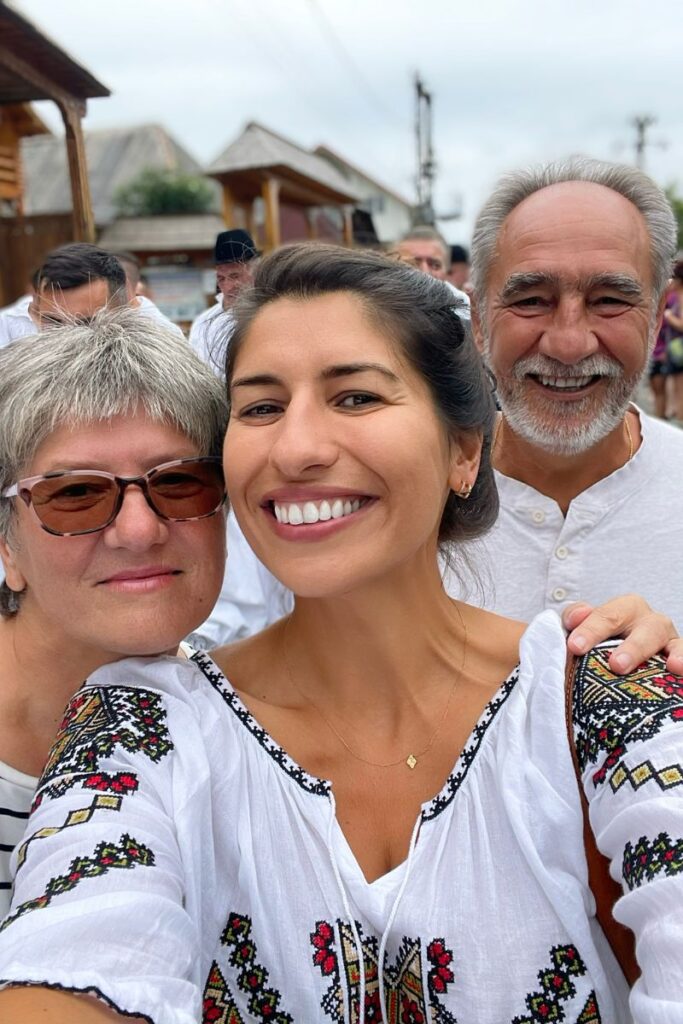
Here’s a quick guide to the highlights of each day of my Romanian road trip and where I stayed.
| Daily Highlights | Where I Stayed |
|---|---|
| Day 1: Arrive in Cluj & Night Out | The Square Hotel |
| Day 2: Drive to Maramureș Visit Merry Cemetery | Casa Moroşenilor Breb |
| Day 3: Explore the Village of Breb Hiking: Creasta Cocoșului | Casa Moroşenilor Breb |
| Day 4: Maramureș Village: Vișeul de Sus Old-School Train Ride in Mountains | A Frame Cabin |
| Day 5: Drive to Bucovina Traditional Romanian Dinner | Casa Baciu Colacu |
| Day 6: Bucovina Viewpoints Hiking: Pietrele Doamnei | Casa Baciu Colacu |
| Day 7: Bucovina Painted Monasteries | Casa Baciu Colacu |
| Day 8: Drive the TransRarau Mountains Arrive at Red Lake (Lacu Roșu) | Hotel Lacu Rosu |
| Day 9: Day on Red Lake & Hiking | Hotel Lacu Rosu |
| Day 10: Drive to Brașov & Explore Visit Bran Castle (Dracula’s Castle) | 1910 Boutique Hotel |
| Day 11: Drive to Sibiu & Explore *This Is My Favorite City | Rabbit Hole |
| Day 12: Turda Salt Mine Dinner & Hot Tub in Rimetea | Conacul Secuiesc |
| Day 13: Village of Rimetea Hiking: Piatra Secuiului | Conacul Secuiesc |
| Day 14: Drive to Cluj & Fly Home |

In my opinion, and you’ll see why, these are some of the prettiest regions and places in Romania. And not enough people know about it!
Now, let’s dive into the planning, logistics, and itinerary for my favorite Romanian road trip!
Where To Start Your Romania Road Trip
If you’re coming from abroad, you’ll likely find a good flight to Bucharest International Airport (OTP), our capital. From here, I would connect to Cluj-Napoca International Airport (CLJ), rent a car, and start your road trip.
👉 TRAVEL TIP: Because we are focusing on the northeastern part of the country, I recommend starting your Romania road trip at Cluj-Napoca International Airport. If you start in Bucharest, it will be A LOT of driving (too much, in my opinion).s
Here are the main airport hubs in Romania and their codes so you can start planning:
- Henri Coandă International Airport (OTP): Romania’s busiest airport, located in Otopeni, a suburb of Bucharest, our capital. Location-wise, this is in the southeast of the country and where your international flight will likely land.
- Avram Iancu Cluj International Airport (CLJ): Romania’s second busiest airport, located in Cluj-Napoca in the middle of the country. I recommend connecting here for this 2-week road trip in northern Romania.
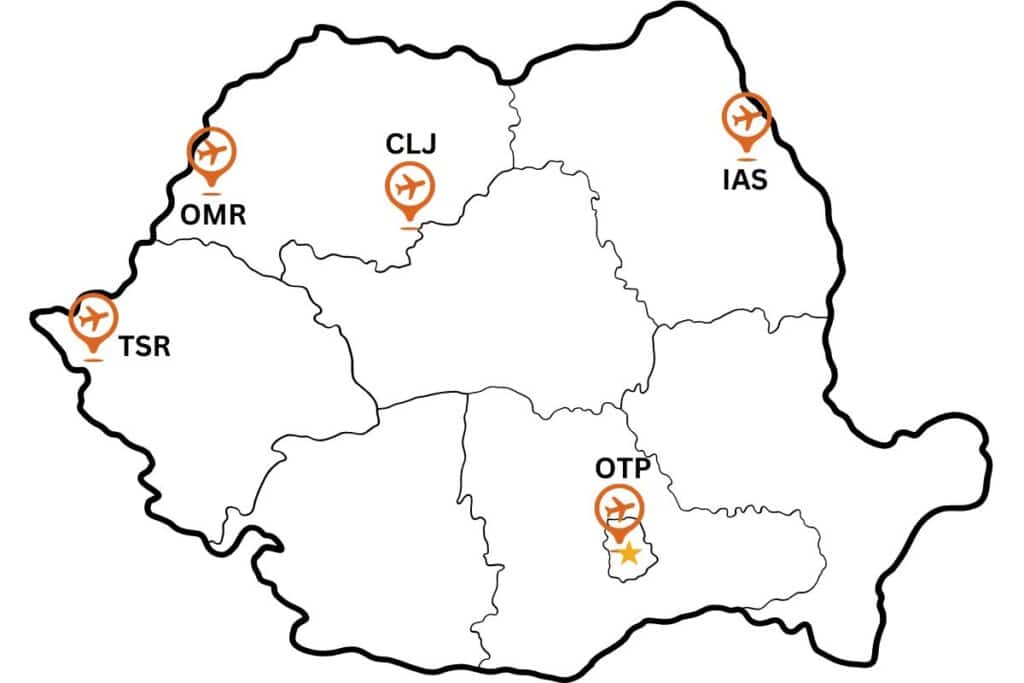
➡️ TRAVEL INSURANCE FOR YOUR ROMANIA TRIP⬅️
As you start booking your trip to Romania, make sure you have travel insurance sorted out. My favorite, and the one I use, is SafetyWing Nomad Insurance because it’s pretty comprehensive and more affordable than some of the other travel insurance I’ve researched.
Obviously, prices will vary based on your age, but my total cost was about $56 for four weeks. Luckily, I didn’t have to use it in Romania, but because I was there for 2 months total, I needed peace of mind in case flights were delayed. Or if I got food poisoning because there’s always that Vasile (a common Romanian name) that starts grilling a weird piece of chicken and doesn’t get it quite right. Or I got hurt on one of the hikes I wanted to do.
Travel medical insurance is a must when planning a trip to Eastern Europe because we’re adults, and it’s called being responsible. Insurance is important not just because of the financial side if something goes wrong but also because you’ll be glad to have someone to call and help you sort out hospitals and get medicine abroad – in a foreign language.
2-Week Romania Road Trip
My Romania road trip itinerary will take you through three of the most beautiful regions of my country, Bucovina and Maramureș, as well as through a bit of the Transylvania region when we dip into some cute city visits in Braşov and Sibiu.
📆 LESS TIME? MORE TIME?
If you need to cut a couple of days, I would skip Day 4 because while the Mocanița Train is cute, it’s rather long and kills a whole day. I would also reduce some of the hike days (but not Pietrele Doamnei in Bucovina).
If I could spend more time somewhere, I would add another day in both Sibiu and Brașov, maybe even do a proper guided city tour in both to learn the history. There is nothing like spending a full day exploring cafes, restaurants, nightclubs, etc., to really appreciate the little things!
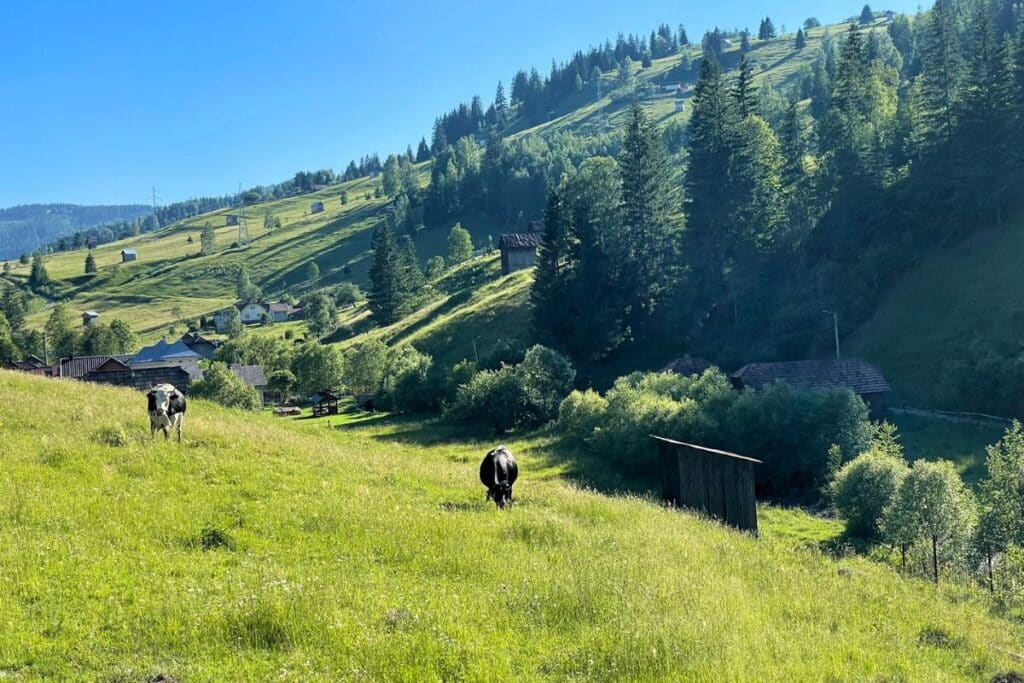
Bucovina and Maramureș are known for their insanely gorgeous landscapes – so much so that our poets write books about these regions!
They are also full of UNESCO World Heritage medieval monasteries and super old, beautifully painted churches. This region is very Christian Orthodox.
Both regions are also known for their traditional village culture—these are called “safe,” where the old school traditions are still preserved. These include making your own cheese from cow milk, manually mowing the “lawn” with a scythe, butchering your own animals, and living off the land.
Transylvania is known for the infamous Dracula and Bran Castle, but it’s so much more than the myth of vampires. It’s a region full of castles, giant mountains, and two of my favorite cities – Braşov and Sibiu (where the houses look like they have eyes!!)
Day 1: Arrive in Romania
Today is about getting to Romania, renting your car, getting settled into the country, and spending the day walking off the jet lag.
Cluj is a university city, and beyond Bucharest, it is one of the more international cities in Romania. When I was walking around, I could hear tons of different languages outside of Romanian – and it was from all the international students!
Places I Loved Eating in Cluj:
- Perfetto for some Italian food in a cute walking area (also where the bars are!)
- Maimuta Plangatoare for a last traditional meal (probably my favorite!)
- Şi – Coffee Shops I loved in the morning before our big drive to Maramureș
MY EXPERIENCE: While Cluj is a big international city in Romania, there’s nothing special about it for me. Personally, I prefer Sibiu, Brasov, and Bucharest. That said, it’s nice to walk around the old town. What I loved was the little coffee shop culture and cocktail bars hidden down the little streets of the old town. Otherwise, it’s the city where we land and take off for this little road trip.
Where To Stay (1 Night):
📍 Luxury: Courtyard by Marriott – For those points, people, this is a beautiful hotel right in the heart of Old Town Cluj. You can expect fancy treatment and wonderful service, as per usual, from a Marriott property.
📍 Mid-Range: The Square Hotel – This is more of a boutique hotel; we loved staying here and being back in the city for one last night before heading out. The beds are big and comfy, and it’s quiet at night!
Day 2: Merry Cemetery
🚗 Drive from Cluj to Merry Cemetery: 4 hrs on DN19 (200km)
🚗 Drvie from Merry Cemetery to Breb: 1 hour (45km)
This is a big drive day from Cluj all the way north to Maramureș. The main attraction point for the day is the Merry Cemetery. After that, we head to the iconic village of Breb for the night.
I recommend grabbing breakfast and heading out of Cluj by 9 am. The idea is to get close to the border of Ukraine in Sǎpânța, where the Merry Cemetery is located, by 1 pm. This way, you can grab lunch near the cemetery and then spend about an hour visiting the grave site.
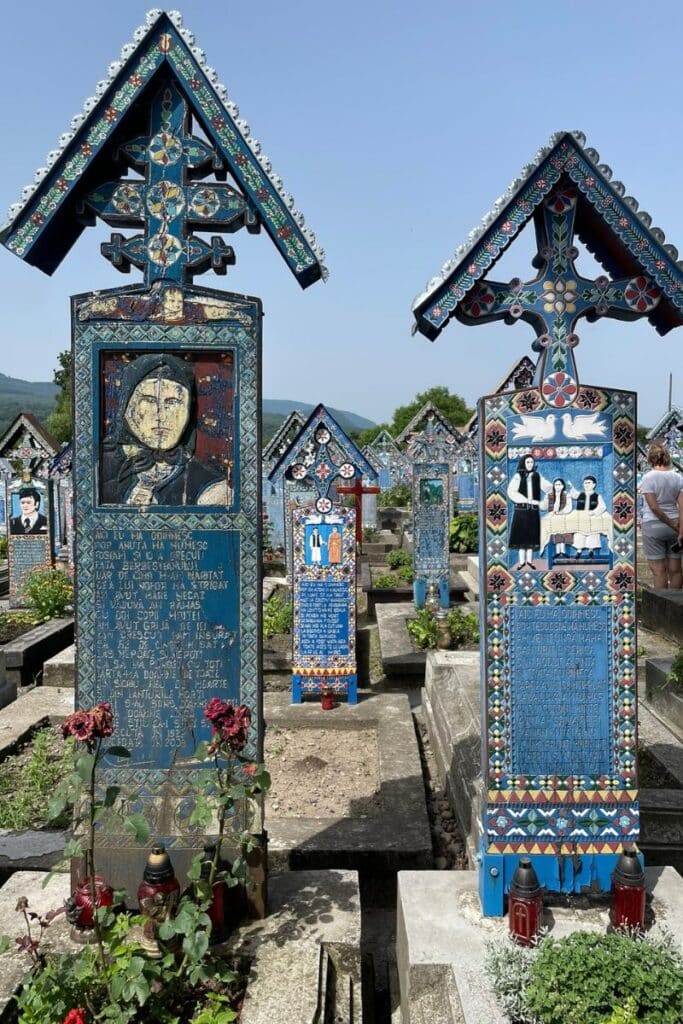
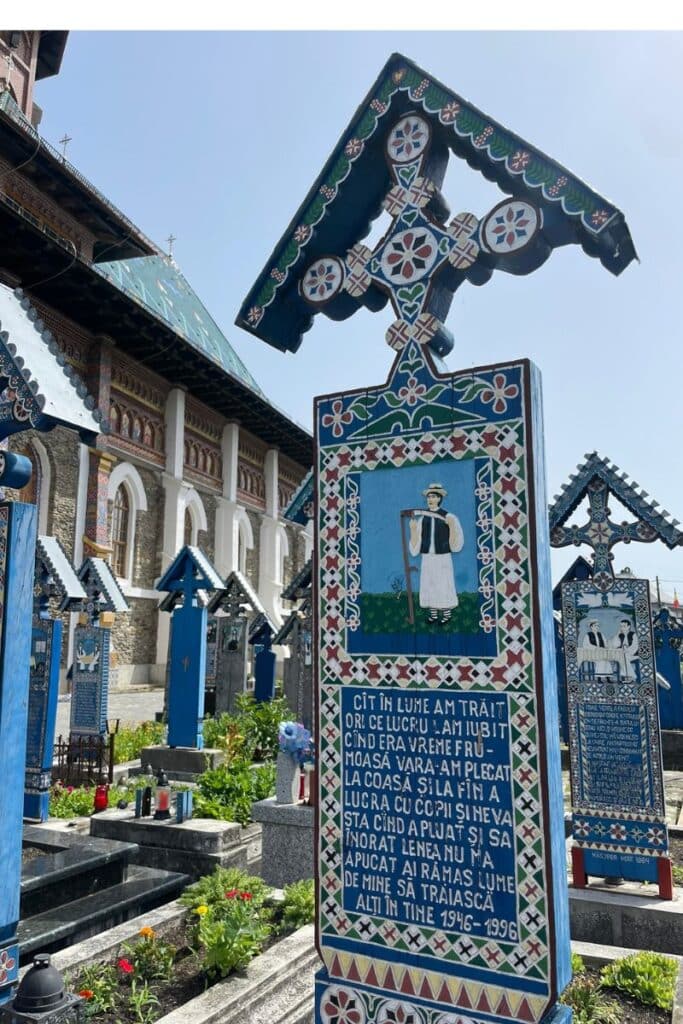
The Merry Cemetery is famous because all the tombstones have a funny little rhyme about the person’s life and death with a bit of a lesson learned. It is all in Romanian, obviously, but it’s a cute spot and an iconic place to visit. If you can snag a Romanian to do a little translation for you, that’s ideal.
You can buy tickets at the gate to go inside, and there are a bunch of little stalls in front of the cemetery itself selling traditional goods. I bought a cute Romanian traditional shirt here for $25.
When you’re ready, drive back down to Breb – it should be about 1 hour to your lodging, which is the cutest little traditional hut.
We got to Breb in the afternoon and had a chill evening, eating and drinking beer with the locals.
My favorite restaurant, and where we ate, was Breb 148. They speak English, and the food is fantastic and homemade. After dinner, we just walked around the village and watched the sunset over the hills while the traditional Romanian music was dying down for the night.
Where To Stay (2 Nights)
📍Casa Moroșenilor – Breb – One of my favorite stays was in Breb. This little village home is totally remodeled, but they’ve kept the authentic vibe of the old Maramureș style alive. It was so quiet at night, and we were waking up to birds in the morning! Oh, and there’s a cute cat that comes along every day for pets!
Day 3: Hiking Creasta Cocoşului & Exploring Breb
After breakfast in Breb, we spent the big part of our day hiking around Creasta Cocosului. This is a beautiful but tougher end-to-end hike that’s 4 hours out and 4 hours back, but just remember, you don’t have to do it all. If you decide to go for it, pack lunch or some snacks.
Once back from our hike, we grabbed dinner in Breb at the only other restaurant in town, Restaurant Traditional Casa lu Dochia, and it was super delicious. Their homemade lemonade is incredible!
MY EXPERIENCE: I was in Breb on a Sunday for Sînziene Celebration, and we went to the biggest church in town to watch the locals do their thing. Sînziene happens in June, and it is a pagan traditional summer solstice celebration. Still, the big thing I want to impart to you is that everyone dresses up in full Romanian traditional gear on Sundays. There’s usually always a little religious festival you can attend! It was magical.
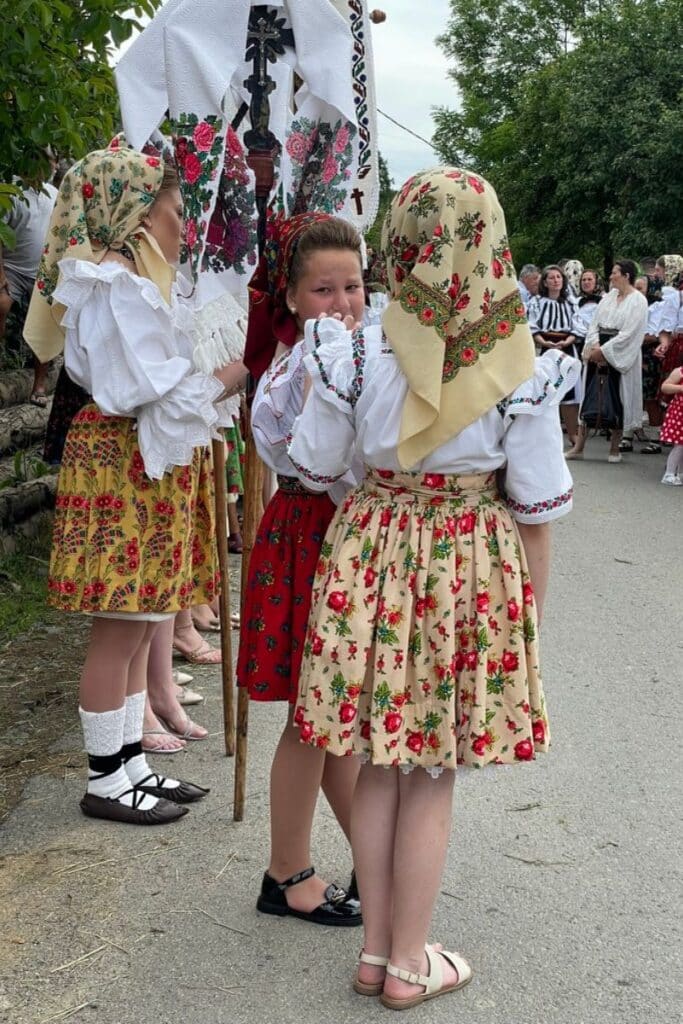
Day 4: Mocǎnița Maramureș Train Ride
🚗 Drive from Breb to Vişeul de Sus: 1.5 hours (65km)
**MUST GET TO TRAIN STATION BY 9:30 am TO GET ON TRAIN!
Today, we left Maramureș and headed towards Bucovina, but with a day stop in Viseul de Sus for an incredible old-school train experience.
The train only leaves once a day at 9:30 am, so you can’t miss it. Also, because this is a full-day experience, we decided to stay the night in the town.
- Website for booking the train ride: https://mocanita-maramures.com/
- Duration: 6 hours back and forth through beautiful landscapes & mountains.
- Cost: $20-30 a person (with meal)
- Starting/Ending Point: Gara Viseul de Sus Train Station
- PRO TIPS:
- Train leaves at 9:30 am so plan your schedule to arrive and park accordingly.
- Get there early so you have a parking spot, especially during the summer.
- Sit on the left side of the train. It’s where the best views are.
- I would also either pack snacks or get the “meal included package” because it’s a long trip.
Where To Stay (1 Night)
📍 Luxury: La Antigua – Big, beautiful house. It felt like we were back home in the States! This is great if you’re a bigger group since it’s got 4 big bedrooms and a giant living room & kitchen.
📍 Mid-Range: A Frame Cabin – LOVED! We’ve always wanted to stay in one of these, so we went for it. It was cozy, and again, the views from the swinging bench out front is what I think makes this part of Romania my favorite.
Day 5: Maramureș Wooden Churches
🚗 Drive from Vişeul de Sus to Fundul Moldovei, Bucovina: 2 hrs (122km)
After breakfast in Vişeul de Sus, we kept going towards Bucovina. The drive is a little over 2 hours, but we stopped a few times and took it slow.
One great stop (a bit out of the way but worth it!!) was at Birsana Monastery, a UNESCO World Heritage Site, and a super pretty example of Maramureș wood architecture with its unique gates.
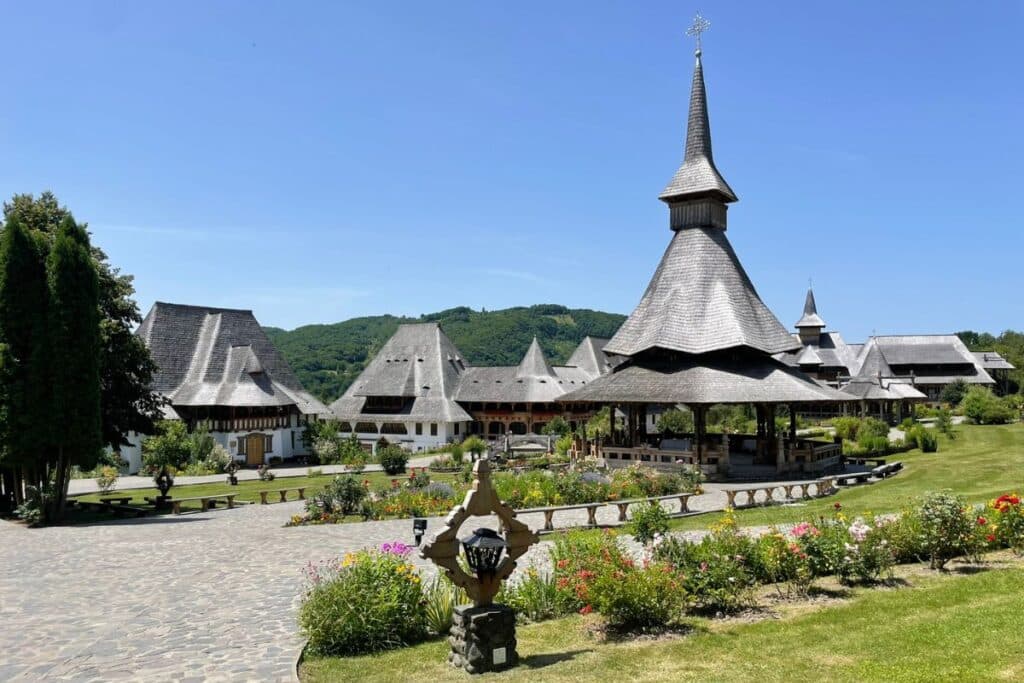
You will notice there is a big difference in the Bucovina and Maramureș styles of churches. Maramureș, I think, is all about the wood carvings, and Bucovina is about painting the outsides of their churches. Both are so unique and pretty!
Another great stop is Horses’ Falls – just to stretch the legs and get some fresh air, walk around for 1-2 hours.
We arrived in Fundul Moldovei in the heart of Bucovina just in time for an early dinner and wine wind down at a beautiful property in the middle of the mountains. We ate hribi soup (mushroom soup), pastravi (grilled fish as a main dish) and mamaliga (cornbread). For dessert, I recommend the papanaşi (donuts with sour cherry compote).
Where To Stay (3 Nights):
📍 La Baciu Colacu – Very authentic mountain cabin with an upscale vibe. My dad was saying only rich Romanians go here, and I think it’s true. That said, it’s so worth it for the beginning of the trip. Every meal is home-cooked, the area is walkable, and the views from the rooms are insane!
Day 6: Hiking Bucovina & Voroneți Monastery
🚗 Driving From Fundul Moldovei to Pietrele Doamnei Hike: 30 min
🚗 Driving from Hike to Voroneți Monastery: 1 hour (44km)
After breakfast at the lodge, we started the morning with a little hike at Pietrele Doamnei – you can park here. This is a circuit hike, mid-level difficulty, and should take about two hours. There’s a bit of scaling and chains you can use for the last little bit, but nothing too crazy.
While I know people are scared of bears in Romania, we were prepared with little bells on our packs. There are tons of people hiking this trail in the summer, so it should be ok.
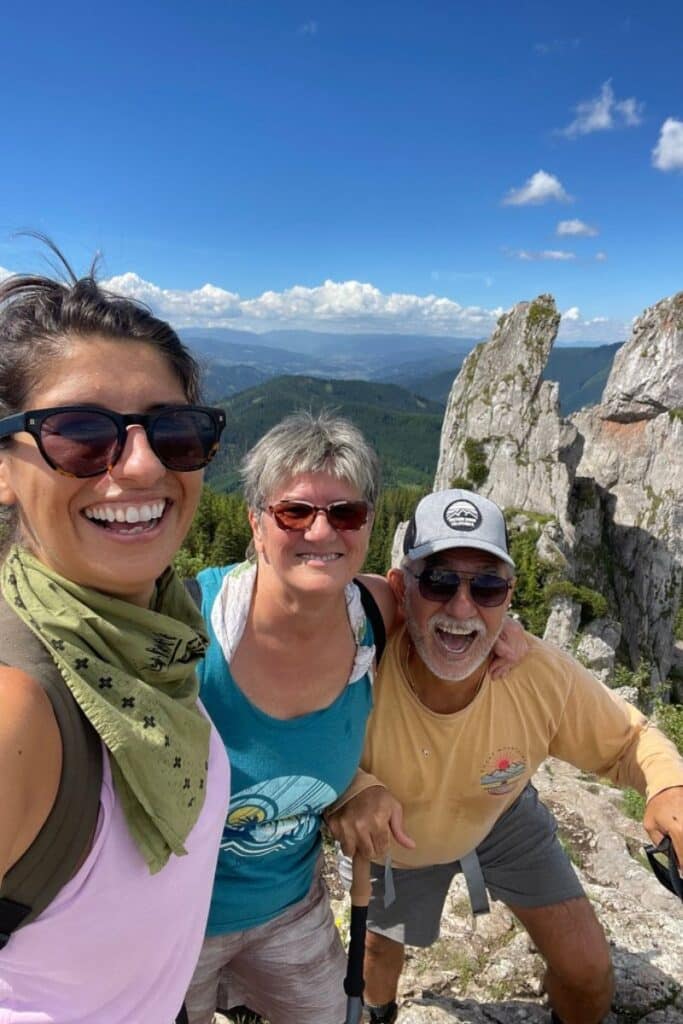
After the hike, we had lunch at Hotel Alpin Rarau, right where we parked, and had the ciorba de vacuta (cow soup). It’s a Romanian specialty.
OPTIONAL WALK: After lunch, we drove another 30 minutes to Cheile Moară Dracului. Getting there, the last few kilometers are unpaved, but be brave and drive to the end of the road, where you will see a barrier. From there, walk 30 min to the “chei” which is roughly translated as little gorges through the mountains. This is a quick little back-and-forth walk through the woods, but it’s pretty next to the river.
The afternoon is all about one of the more famous Bucovina Monasteries, so it’s another 1-hour drive to Voroneti Monastery, a UNESCO world heritage site.
I’m not very religious, but this was incredibly pretty. Its exterior is painted with blue-colored religious scenes, one side being more bold than the other due to the sun and weather conditions.
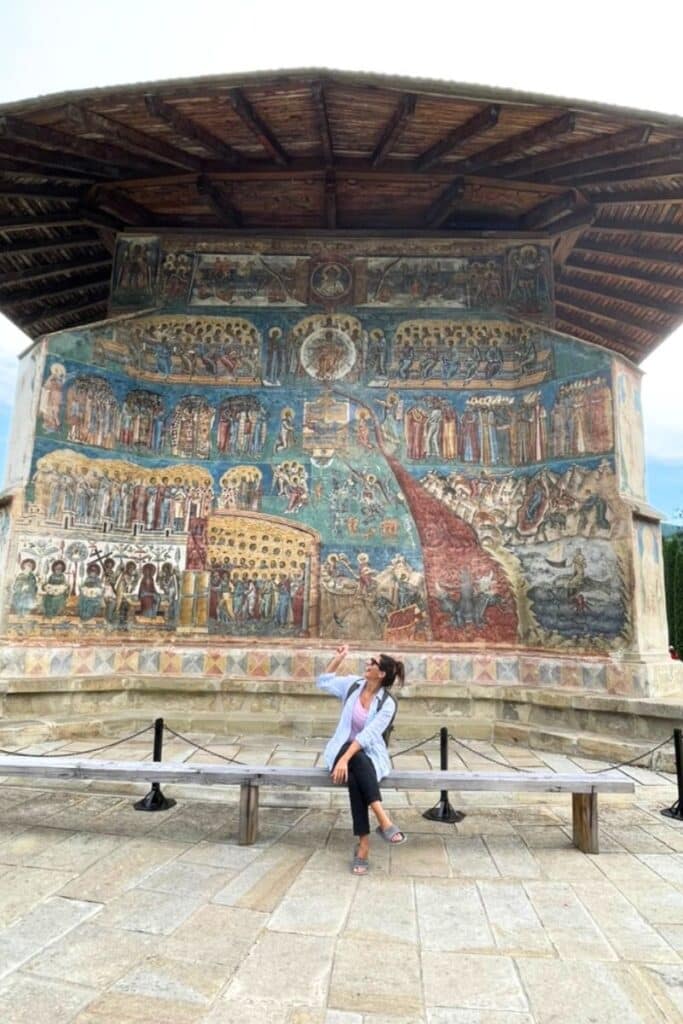
It’s 10 LEI to get in per person, and you will have to make sure you’re not dressed like a little hoe. Before you leave, you can walk down the main market street and shop for souvenirs.
TRADITIONAL ROMANIAN COSTUME PICTURES: Don’t miss the opportunity to take traditional costume portraits – ODAIA BUNICI Photography Shop. We did it, and it is one of our favorite memories from the trip.
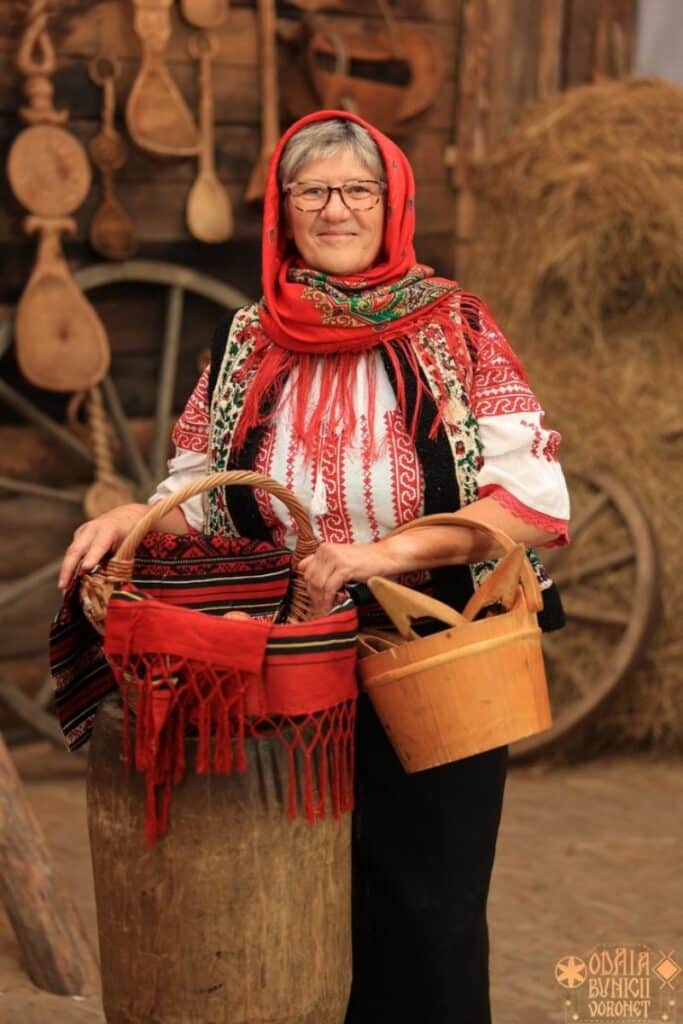
Day 7: More Bucovina Painted Monasteries
🚗 Drive Time from Fundul Moldovei to Sucevița Monastery (furthest): 1.5 hours (62km) with stops along the way.
We started the morning after breakfast at the Panorama Bucovineana, just 30 minutes from the lodge. When you get to the location, you have to call the number on the ad, and the lady will instruct you how to get up to the viewpoint. She speaks English.
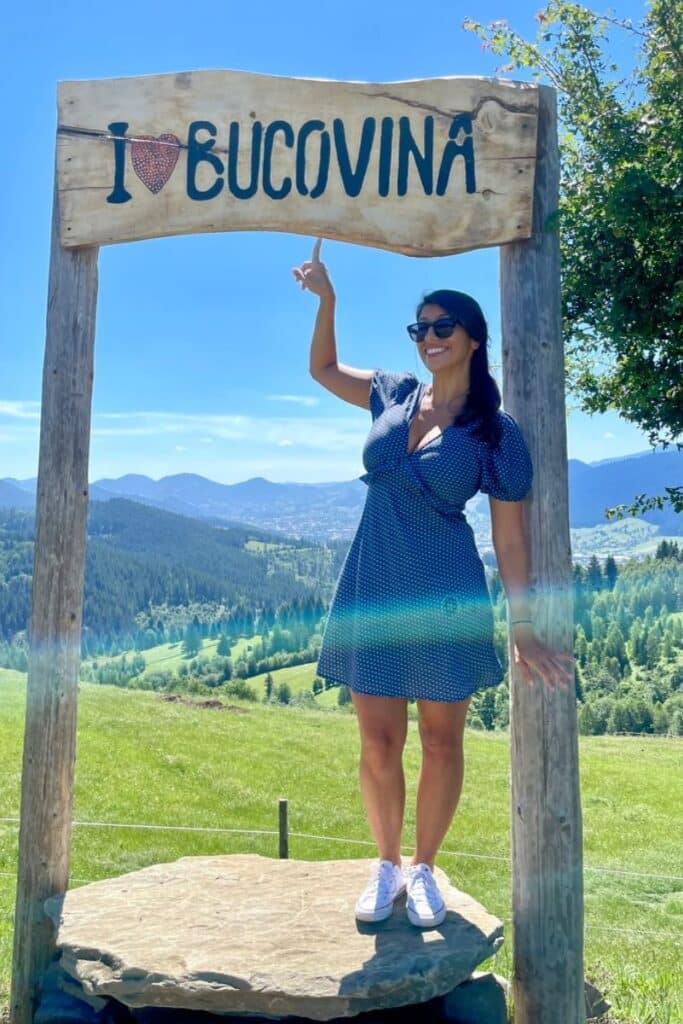
We paid 25 LEI a person and left the cash in a jar at the top. It was super low-key but very pretty. We spent about an hour taking pictures and enjoying the view from the swings and tree house.
From here, we head up north another 30 minutes to Moldovița Monastery. I think what stands out to me the most about these painted monasteries is their gardens – the nuns who run this place plant the most amazing roses!
Then, keep going north through and across the mountains, stopping at La Palma (The Hand). Here, we grabbed some snacks and a small coffee – enjoyed the view and recovered from the serpentine roads.
ZIP LINING AT LA PALMA: La Palma is an adventure park where you can go zip lining. You need to call ahead and reserve a spot, but they speak English: https://www.tirolianapasulpalma.ro/
From Palma, we drove another 30 minutes to my favorite monastery of the day, the UNESCO World Heritage site of Sucevița. It is stunning!
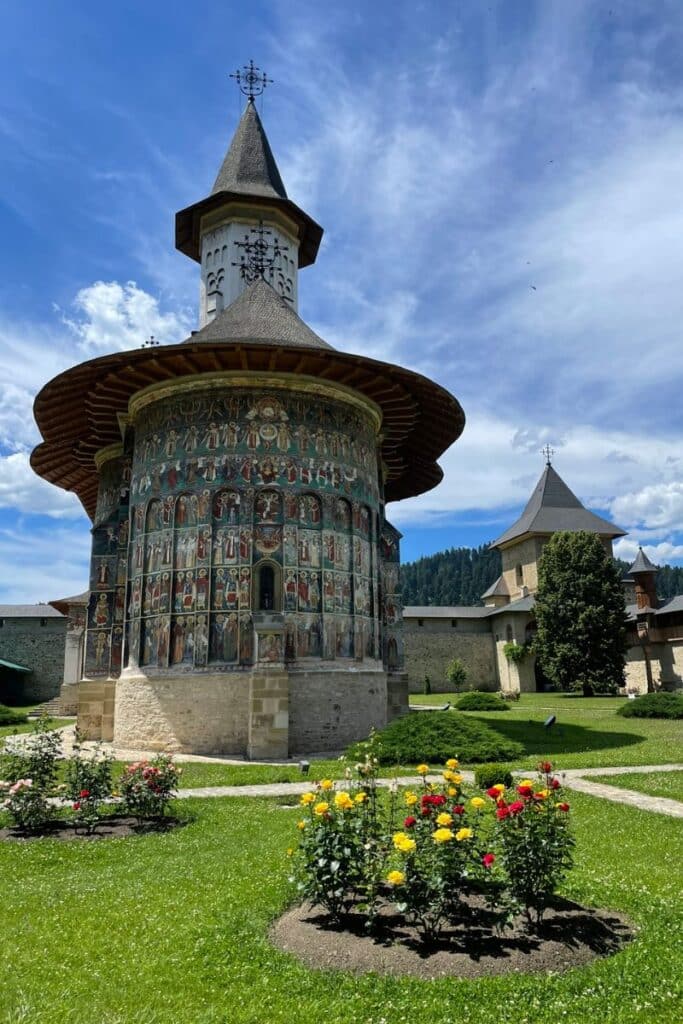
After spending another hour walking around the grounds, we headed back across the mountains to our lodge. From Sucevita Monastery to Fundul Moldovei is about 1 hour, but 1.5 to be realistic.
Day 8: TransRarau Drive to Cheile Bicazului
🚗 Drive Time from Fundul Moldovei to Lacul Rosu (Red Lake): 4 hrs (171km)
**A beautiful drive through serpentine mountain roads.
This is a big road trip drive day through some of the more beautiful mountains of Romania.

We had nothing on the agenda except to take it slow, stop at the pretty viewpoints for pictures, and test out some of the roadside Pensiunes and Hans for lunch.
DID YOU KNOW? When you see a HAN or PENSIUNE restaurant on the side of the road, there’s a good chance you’ll get fantastic home-cooked traditional Romanian food. Stop here to eat, especially if there are tons of cars in the parking lot.
We got to Red Lake in the afternoon and just took the time to unwind. Dinner was right on the lake at Panorama.
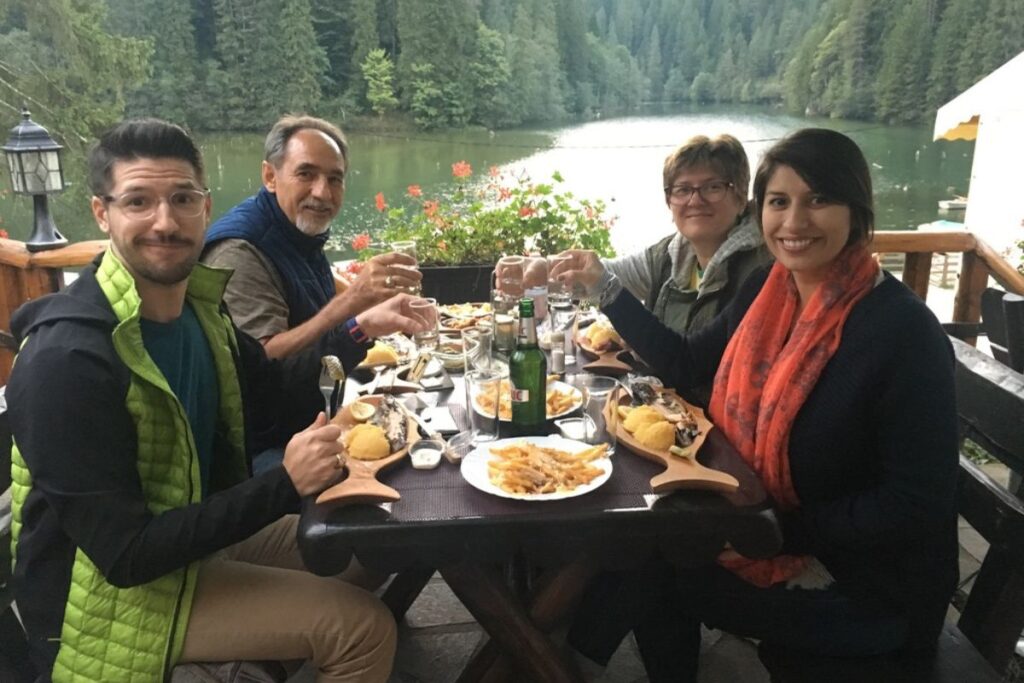
Where To Stay (2 Nights):
📍 Hotel Lacul Roşu – This is the nicest property on the Red Lake, and the reason we picked it was for the views – they host weddings here as well, so the property itself is beautiful. We toyed around with staying at one of the Pensiune up the road, but we really wanted to see the lake from our room.
Day 9: Red Lake Day (Lacul Roşu)
No more driving today – just chilling on Red Lake. You can rent a boat and go out on the lake or do a few nearby hikes. We opted to sunbathe and go to the lake.
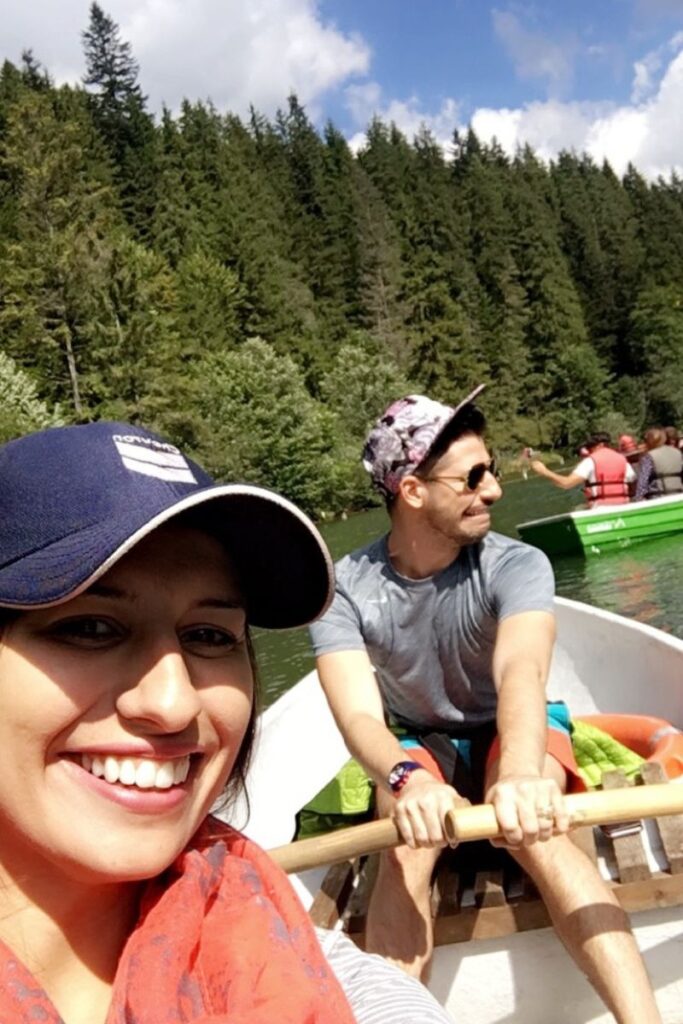
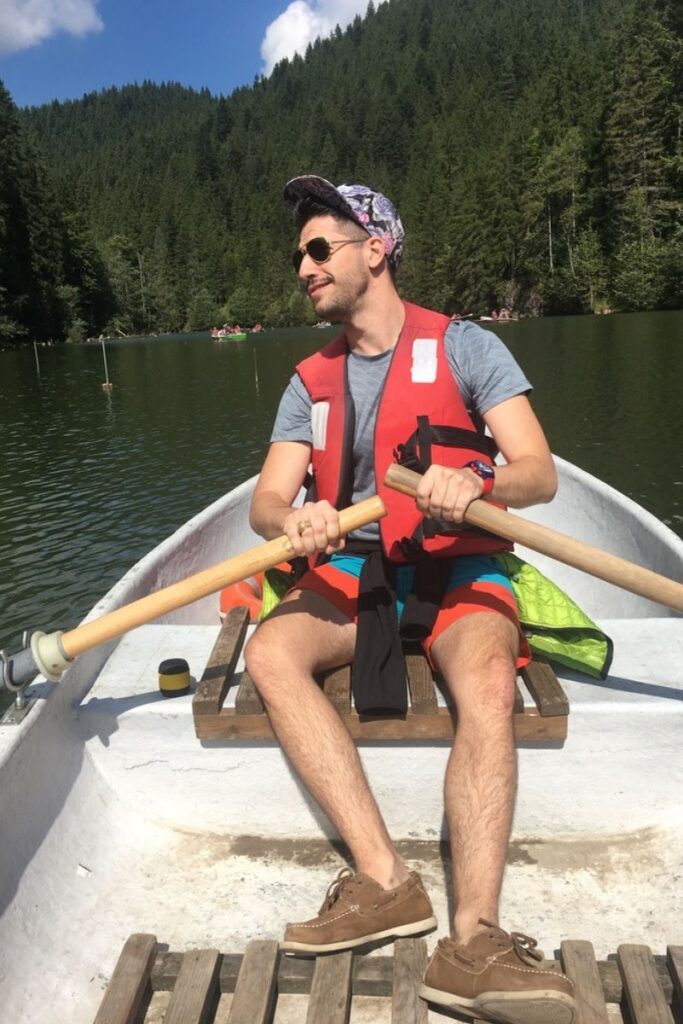
SAD FACTS: My parents told me the Red Lake got its name because there was a big avalanche from the mountains surrounding it that killed the entire village on the lake, making the water red with the blood of the deceased. God, Romanians are dark! ☠️😳
Day 10: Brașov & Dracula’s Castle
🚗 Drive from Lacul Roșu to Brașov: 3.5 hrs (300km)
🚗 Drive from Brașov to Bran Castle: 30 min (30 km)
Today is another big drive morning, where we dip into the Transylvania region and into my favorite two cities over the last couple of days – Brașov and Sibiu.
The drive from the mountains where Cheile Bicazului are to Brașov is about 3.5 hours, and we aimed to be in the city and checked in by lunch.
After lunch, we visited the famous Bran Castle (park here), which is famous for being “Dracula’s Castle.” Obviously, that vampire stuff is a bit of mumbo jumbo, but the castle visit and the little town around it are quite cute.
SCHEDULE NOTE: The castle is open to visit from 9 am – 4 pm, and admission tickets cost about $20. It was kind of nice because we were on the last tour before it closed, so it was extra creepy walking around with very few people.
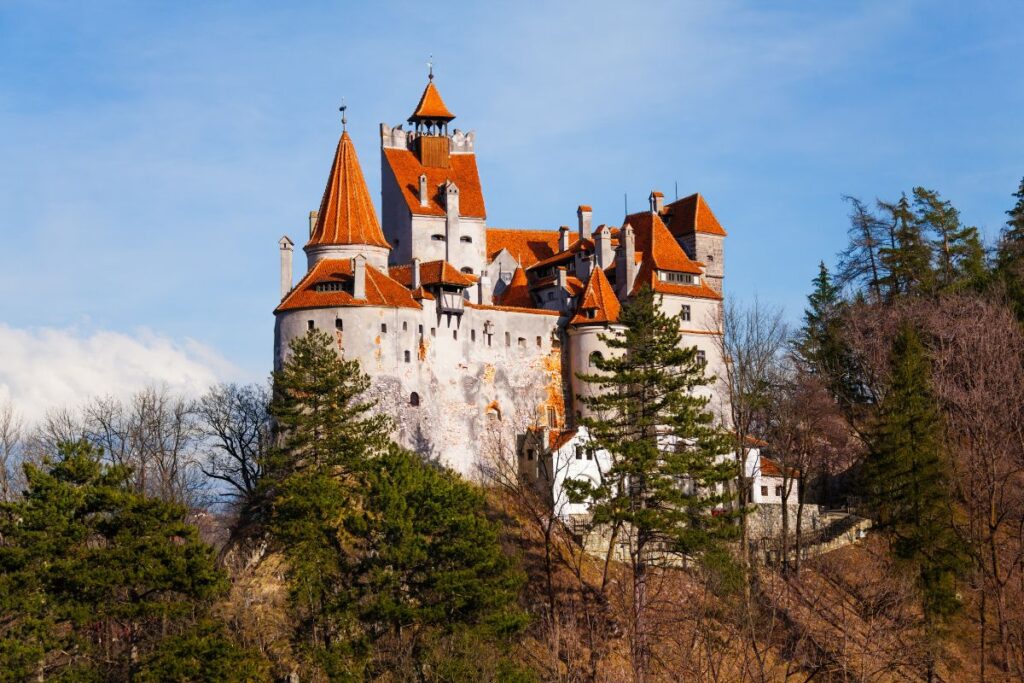
I personally think Bran Castle is a tourist trap, but if you’re in Romania and in Brașov, you might as well go for it; at least check it out from the outside and walk around the gardens.
In the late afternoon, we were glad to be back in Brașov, where we had family show us around.
A few places I loved in Brașov:
- Roata Norocului – traditional Romanian food, and live band some nights
- JUNO Wine Garden – great for a pizza dinner and drinks, a bit more modern and chic
- Clǎtita Zapacita – these are famous Romanian crepes, and the best ones have Nutella in them!
Where To Stay (1 Night):
📍 1910 Boutique Hotel – There are a bunch of cute places in Brașov, but we wanted something a bit more upscale in the city center, especially for one night out on the town. This is a great value for the money spot, and it’s a beautiful property – very artsy!
Day 11: Sibiu & Little Houses With Eyes
🚗 Drive from Brașov to Sibiu: 2.5 hrs (150km)
From Brașov to Sibiu is a 2.5-hour drive, and again, you’ll want to get to the city by lunch. If I could live anywhere in Romania, I would pick Sibiu first, and then Brașov and Bucharest as a close second.
Sibiu is one of my favorite towns for a few reasons – mostly related to architecture, food, and culture:
- Eyes of Sibiu: The old town’s distinctive roof windows, known as “eyes of Sibiu,” seem to “watch” over the streets and everyone below – quirky and a bit creepy in my opinion!
- European Capital of Culture: In 2007, Sibiu became the first city in Romania to hold the prestigious title of European Capital of Culture, sharing the honor with Luxembourg.
- Home to Romania’s First Theater: Sibiu is home to Radu Stanca National Theatre, one of the oldest and most prestigious theaters in the country, hosting international festivals like the Sibiu International Theatre Festival.
- Romanian Michelin Stars: Sibiu boasts Romania’s first Michelin-star restaurant, reflecting its reputation as a hot spot for foodies. My favorites are SIA Restaurant and JAR’S Steak & Spritz.
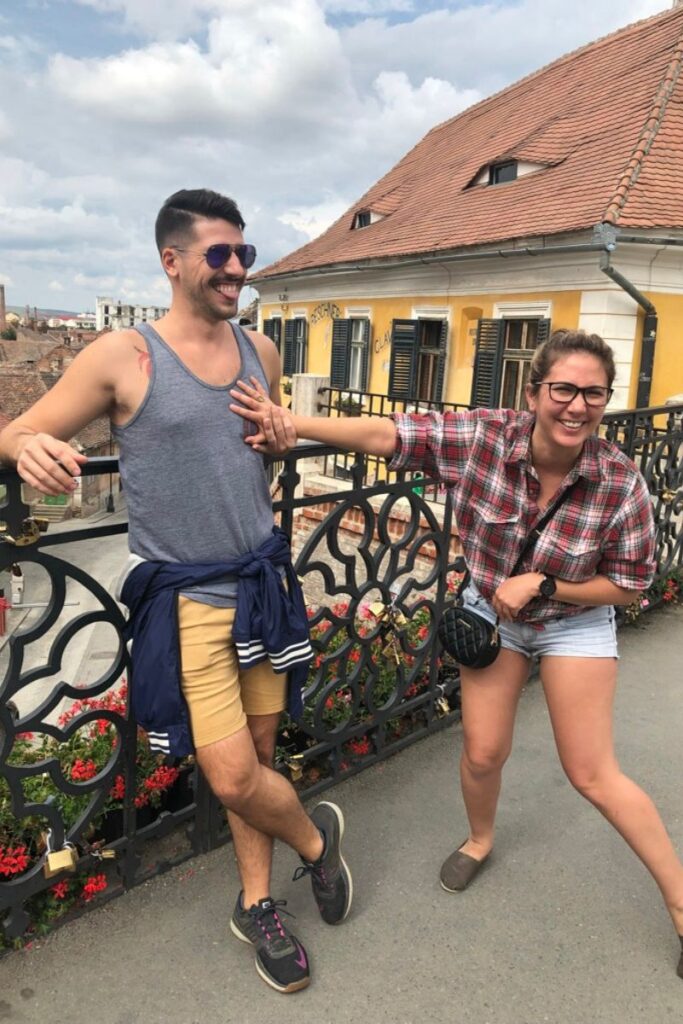
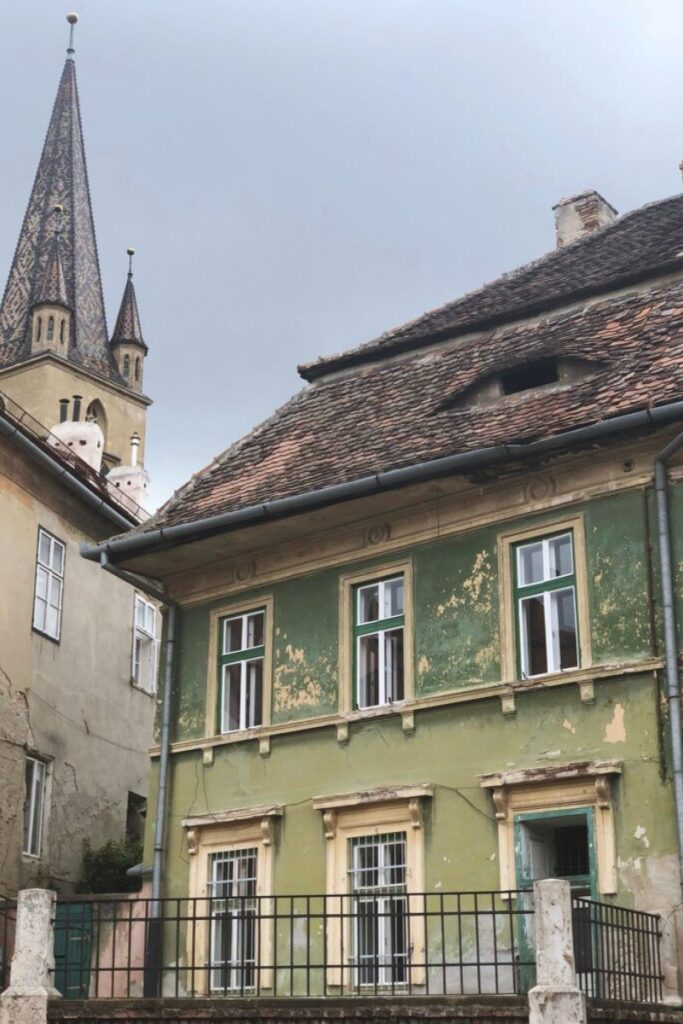
Day 12: Turda Salt Mine
🚗 Drive from Sibiu to Turda Salt Mine: 2 hrs (150km)
🚗 Drive from Turda Salt Mine to Rimetea: 40 min (36km)
Today, we’re visiting the famous Turda Salt Mine and end up in the cutest little Hungarian-Romanian town near Rimetea for the last couple of nights in Romania.
From Sibiu to Turda Salt Mine is about a 2-hour drive. When we got to Turda, we had lunch in town first and then bundled up and went down into the salt mine (it’s cold down there).
- Turda Salt Mine Website: https://www.salinaturda.eu/
- Location & Parking here
- Cost: ~$10 for adults (30 LEI). You can buy tickets at the door
- Hours: 9 am-5 pm
- Duration: We spent about 2 hours wandering around
- PRO TIP: It’s cold in the salt mine, so we wore jeans, sneakers, and a jacket. Also, there are tons of stairs. By the way, there is no food or drink down there, just fun little games like ping-ping, boat rides in the dark, scary lake, etc.

After the salt mine, which I thought was pretty well-managed for a Romanian tourist attraction, we kept going to our destination village for the night, Rimetea. It was a short 45-minute drive to the village.
I loved the place we stayed in Rimetea (technically, the village right next to it is called Colțesti)—it is actually a Romanian-Hungarian lodge called Conacul Secuiesc. It’s like a tiny authentic resort, and I spent the afternoon in the rustic hot tub and had dinner overlooking the sunset and the mountains.
Where To Stay (2 nights)
📍 Conacul Secuiesc – LOVED! I insist and highly recommend staying at this property. It’s a Romanian-Hungarian lodge, and the decor, food, and hospitality are beyond excellent. They have an authentic sauna, hot tub, games for kids, a local dog, homemade food things, and the best țuica made of both plums and pears I’ve tasted since my grandpa’s.
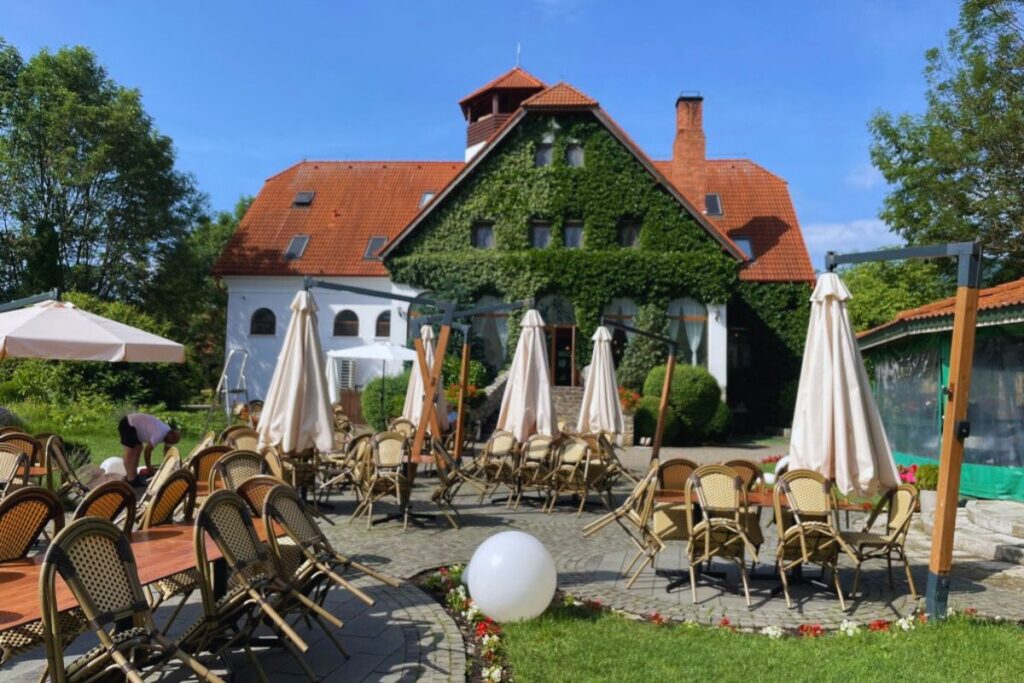
Day 13: Hike & The Village of Rimetea
No driving today, just a shit-ton of walking. After breakfast, we decided to head up Piatra Secuiului, which is the giant mountain in front of the lodge. This was a 6-hour loop hike, exhausting but beautiful!
All Trails Hike: This is not the exact trail, but close to what we did. The difference was that we started in Colțesti and went all the way up to the very top, looping back down to catch the trail at the foothills of the mountain.
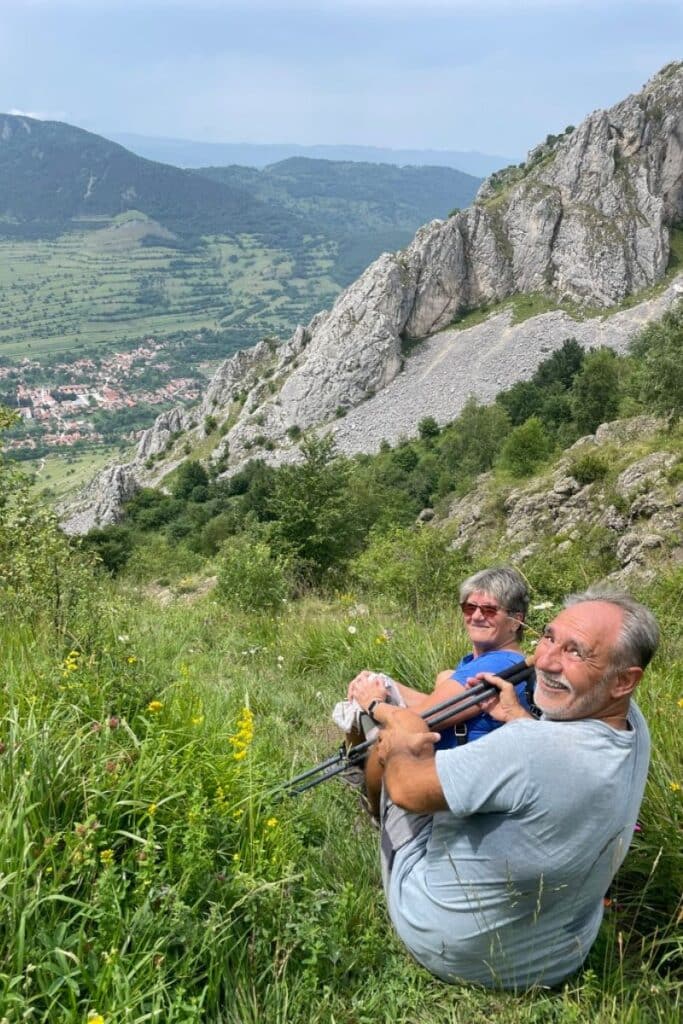
That afternoon, another hot tub session, dinner, and sunset at the lodge.
Day 14: Cluj-Napoca & Fly Home
🚗 Drive from Rimetea to Cluj-Napoca Airport: 1.5 hrs (65km)
For our last day, we left Conacul Secuiesc in the morning and went into the town of Rimetea for a quick look. We spent about one hour wandering around the small village center and visiting the Ethnographic Museum to see all the old ways and costumes people wore.
After that, you can just head back to the Cluj to catch your flight. The drive from Rimetea to Cluj is about 1.5 hours.
Romania Road Trip Map
Renting a Car in Romania
Renting a car in Romania is pretty straightforward. You will need to present your driver’s license and an International Driver’s Permit when you pick up your car, as well as the credit card you used to book the reservation.
➡️ I personally rent and recommend Discover Cars for car rentals in Romania. ⬅️
For this road trip, you don’t need any off-roading 4×4 or anything fancy. I made this whole trip with a small sedan, and it was fine, even on some of the unpaved village roads.
👉 PRO TIP: I recommend renting from a well-rated company, anything 7+. I rented from Klass Wagen, a local Romanian company, because it was cheaper than Alamo or Sixt, and it was great. The customer service folks spoke English, were nice, and really helpful. They had a shuttle pick us up to bring us to their office 5 minutes from the airport, and everything went smoothly.
Also, make sure to get at least the basic car insurance – you’ll want peace of mind since some of the roads will be more rustic, tree branches will be scratching the sides of your car, you might be parking in a field, and things like this.
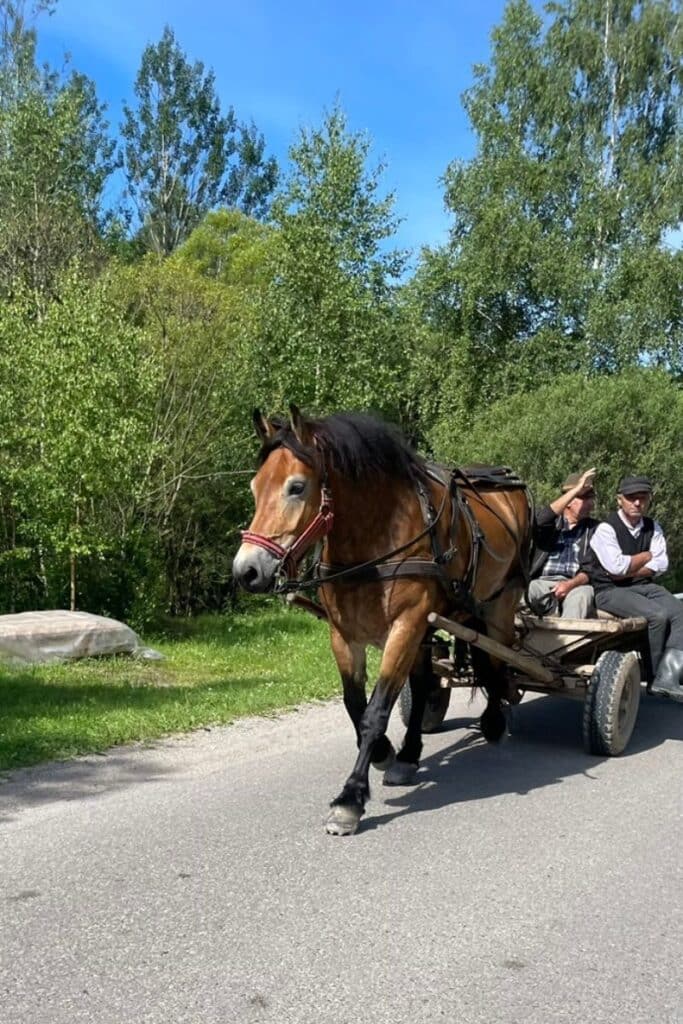
Driving in Romania
Driving in Romania is an adventure. I’ve driven in 40+ international countries, and in my opinion, the drivers are a bit aggressive in my country, especially when trying to pass you on the highway.
As far as road conditions, the highways and major roads are pretty good, which is a welcome surprise from the clusterfuck of 15 years ago when I used to visit. It’s good to see that some of the infrastructure has improved and that the EU funding is going to be of good use.
➡️ Road Labels & Driving Tips:
- DN – Drum Național (national road/highway)
- DJ – Drum Judatean (more local road)
- The smaller the number, the better the road (ie. DN1 is better than DJ574)
Another tough part about driving in Romania is the hectic traffic, especially around big cities like Bucharest and Cluj-Napoca, and especially when you’re trying to exit the airport.
Traffic also backs up when a farmer drives a one-off horse and carriage in the middle of the road — yes, that’s still a thing in Romania.
That said, there are still dirt roads and plenty of potholes in some of the more rural villages; it is still Eastern Europe, after all.
❌ CAUTION: Stay away from “forest roads” or “drum forestier” on Google Maps. These are off-road hell for your car rental. We accidentally took a few of these in Maramureș, so I advise caution.
My Best Romania Road Trip Advice
Before you go to Romania, here is some basic Romania knowledge so that you’re not the biggest newby in town:
- Capital: Bucharest
- Currency: Romanian Lei (RON)
- Population: ~20 million
- Language: Romanian (English is widely spoken except in the small villages)
- Gas Stations with Cleanest Bathrooms: PETROM first, and OMV second.
- Best Road Trip Food: When you see a HAN or PENSIUNE restaurant on the side of the road, that’s good homemade traditional food. Stop here to eat.
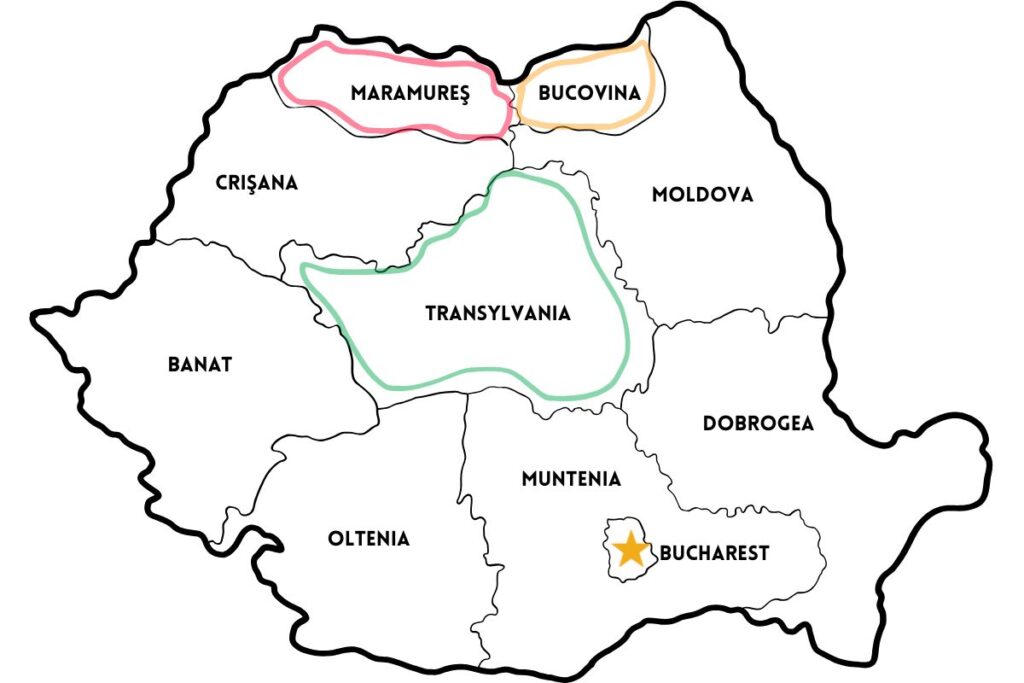
Beyond that, from one traveler to another, there are some quirky things about most Eastern European countries, so here are some frequently asked questions and my travel advice when you’re in my country.
How Many Days Do You Need in Romania?
I think you need at least a week to 10 days to explore a region of Romania.
And because it’s a big country, almost the size of France, and very varied, there’s reason to come back and visit different sections – the mountains, the beaches, the delta (although not my favorite), and the cities and villages bordering Hungary.
What Is The Best Time of Year To Go to Romania?
The best time of year to visit Romania is either in the summertime, July to September, or the winter for its traditions around Christmas and New Year.
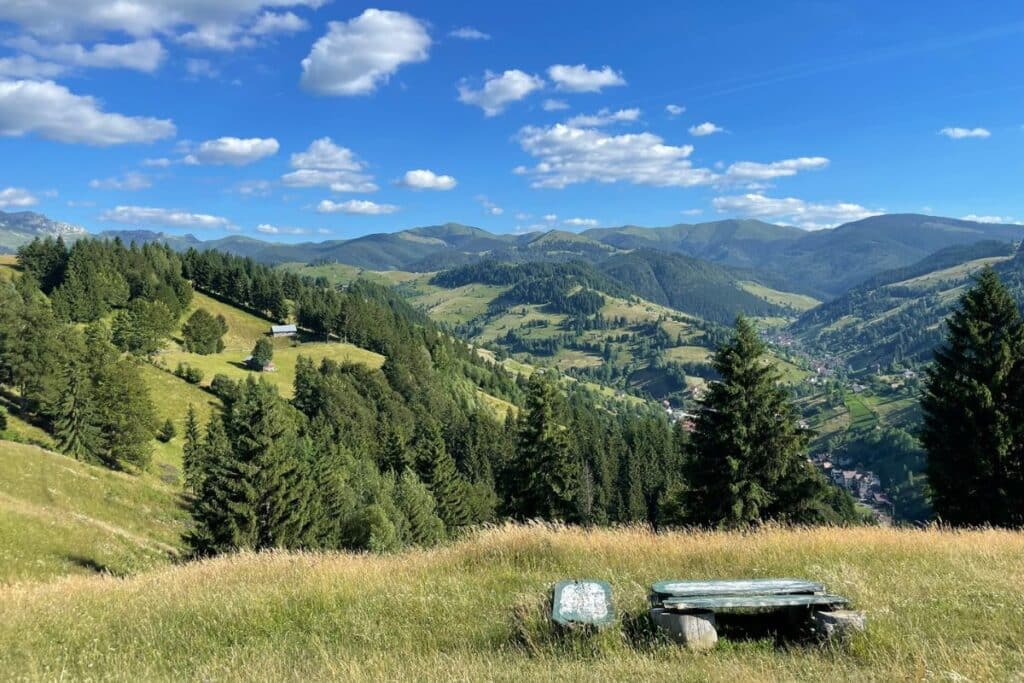
I would say the best and easiest time for a tourist to go on a road trip on their own without a local is the summer. If you decide to go in the winter, you really need to do an organized tour or have a local explaining everything.
The country is just not built for tourism in this way, and so there are few guided tours and explanations, especially in the winter.
Is Romania Expensive?
No, Romania is not expensive. Here is our budget for this road trip:
- Lodging: $50-100 a night – we stayed in cute lodges most of the time, a few splurges, but mostly just mid-range central locations.
- Food: $20-40 a day – we always ate out and well. Breakfast was usually included in our stay, so your money usually goes to lunches and dinners.
- Car Rental: $20-30 a day – this depends on the type of car you get and when you go (high season will be more expensive, so will an automatic vehicle).
Is Romania Friendly to Tourists?
Yes, Romanians are quite friendly, and almost everyone speaks English, except in the little villages off the beaten path. Grandmas and little old people generally only speak Romanian.
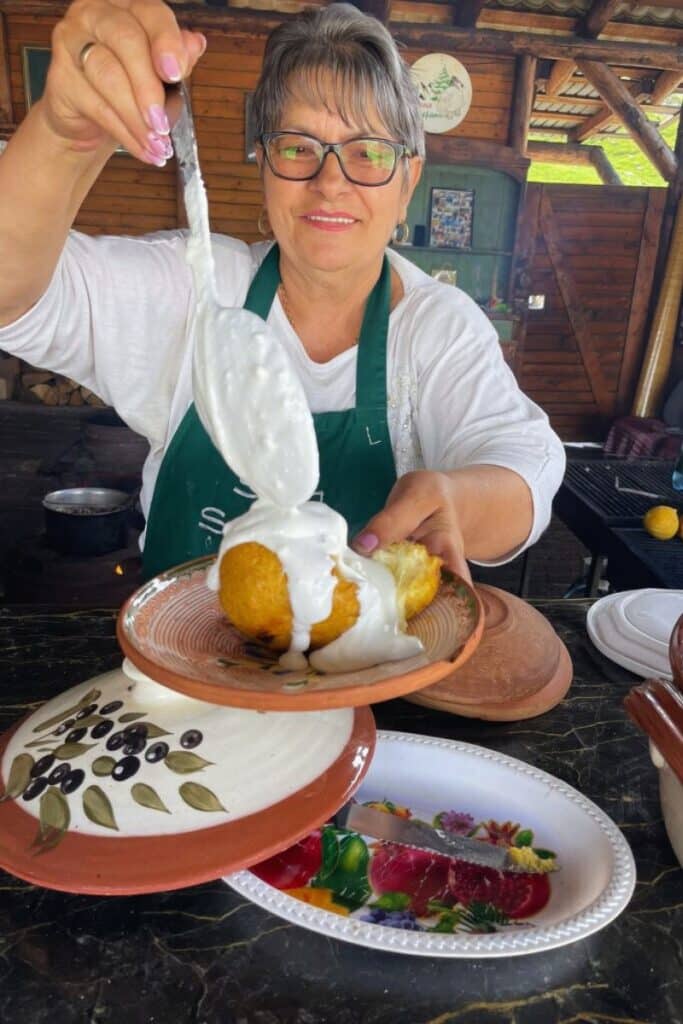
Not only did I find Romanians friendly, but also helpful. Because my Romanian is a bit broken, I found myself speaking English first, and everyone was super nice, helped me, and went out of their way to make me feel welcome.
Final Thoughts: Romania Road Trip
Romania is a beautiful giant country, but if you take one piece at a time via road trip, there’s so much to explore and fall in love with.
When I was a kid, getting shipped back to my grandparent’s place near Brasov, I didn’t get to see much of my country – I just played around with my cousins in the village.
This past few years, I’ve been going back for a month at a time and really digging deep into the different regions and what they have to offer. Bucovina and Maramureș are my favorite areas in the country, and this road trip solidified this for me:
- 1 day: Cluj-Napoca
- 2 days: Maramureș steam train, wooden painted churches, authentic villages
- 1 Day: Mocanita Train Ride in the mountains
- 3 days: Bucovina painted monasteries and traditional life
- 2 Days: Cheile Bicazului and Red Lake
- 1 Day: Brașov & Bran Castle
- 1 Day: Sibiu
- 1 day: Turda salt mine
- 2 days: Rimetea hike and Hungarian-Romanian villages
So what are you waiting for? Get planning!

